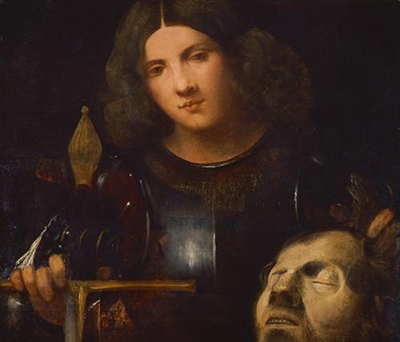 Buy Art Prints Now
Buy Art Prints Nowfrom Amazon
* As an Amazon Associate, and partner with Google Adsense and Ezoic, I earn from qualifying purchases.
David with The Head of Goliath is an oil on canvas painting created by the Italian painter, Giorgione Barbarelli da Castelfranco. Painted in 1510, Giorgione portrayed himself in armour as the victorious David who had just cut off Goliath's head.
The piece of art shows a bust-length portrait of Giorgione as David. The portrait is turned to the right, with the painter's face looking towards the viewer. Giorgione has long brown hair and is standing behind a parapet with his left hand holding the cut-off, bleeding head of Goliath. Edgar Wind, a German-born British interdisciplinary art historian, argued that the Italian painter had made Goliath's head smaller than his own as David which is a clear discrepancy.
He surmised that Giorgione was casting himself as a victorious warrior because his name meant ‘Big George’ when translated to English. In the pictorial language, David – who is portrayed as Giorgione – has just killed Goliath and now presents his head or mind as an example of his piece of art. The giant’s head is David’s head-thoughts and Giorgione’s ability to paint Goliath’s head is seen to be David’s heroic efforts.
Provenance
The fragments of this piece of art are at the Herzog Anton Ulrich Museum in Brunswick. The Brunswick fragment was inventoried in 1528 by Cardinal Marino Grimani and described by Vasari in the Grimani Collection as ‘Ritratto di Zorzon di sua man fatto per David e Golia’. However, in the inventory, it is not clear which head is the self-portrait. Consequently, Vasari decided to use David’s head as the woodcut for Giorgione in the 1568 ‘Vite’. This convention was later followed by other artists.
Inspirations
Giorgione’s painting of David with The Head of Goliath inspired Caravaggio to compose a similar painting. However, Caravaggio captures the happenings more effectively by having Goliath's grimacing, bleeding head dangling from his hand. The painter carries a sword that is abbreviated H-S OS which is an abbreviation of the Latin phrase humilitas occidit superbiam which translates to humility kills pride.
The painter is perturbed with his face expressing sadness and compassion. Caravaggio's decision to portray him as pensive rather than victorious brings out an unusual bond between the two. To further complicate the bond, the Italian painter casts himself as Goliath while the model of David is his own younger Caravaggio. The little Caravaggio holds the head of the adult Caravaggio. The painting metaphorically depicts a scenario where the young Caravaggio’s wild and riotous behaviour has destroyed the painter’s life as an adult.




